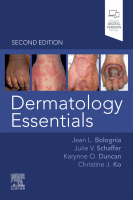Physical Address
304 North Cardinal St.
Dorchester Center, MA 02124

Hypertrophic Scar Firm, initially pink to purple in color then becomes skin-colored to hypopigmented, occasionally hyperpigmented; papule or plaque limited to an excision site or wound ( Figs 81.1 and 81.2 ). Most commonly seen on the trunk and shoulders.…

Heritable connective tissue disorders present with a broad range of cutaneous and extracutaneous manifestations. Recognition of characteristic skin findings is often critical to establishing the diagnosis and identifying associated internal involvement, which may include life-threatening cardiovascular disease, e.g. in the…

Classically, a group of disorders in which there is transepidermal elimination (“perforation”) of components of the dermis, in particular collagen and/or elastic fibers ( Table 79.1 ). Etiologies are multiple and include inherited as an isolated cutaneous disease or inherited…

When histiocytes form granulomas within the skin, the cutaneous disorders are referred to as granulomatous. This group of disorders is further divided into infectious (e.g. mycobacterial infections, dimorphic fungal infections) and non-infectious (e.g. sarcoidosis, granuloma annulare). This chapter focuses on…

Key Points Cutaneous xanthomas are due to an accumulation of lipid, primarily within dermal macrophages (foam cells), and they have a characteristic yellow-orange hue. Four major types of xanthomas: eruptive, tuberous, tendinous, and plane. They may be a sign of…

Group of disorders in which the predominant cell type is a Langerhans cell, a mononuclear cell/macrophage, or a dermal dendrocyte. Traditionally, there are two major groups: Langerhans cell histiocytoses and non-Langerhans cell histiocytoses. The V600E variant of BRAF has been…

You’re Reading a Preview Become a Clinical Tree membership for Full access and enjoy Unlimited articles Become membership If you are a member. Log in here

Cutaneous Injury Due to Heat Exposure Thermal Burns Traumatic injury to the skin caused by an external heat source ( Fig. 74.1 ). The depth of the burn injury depends on the temperature of and the amount of contact time…

Photo Facts The UV radiation (UVR) emitted by the sun is arbitrarily subdivided based on wavelength into UVA (400–320 nm), UVB (320–290 nm), and UVC (290–200 nm). More than 95% of UVR that reaches the earth’s surface is UVA. UVA,…

Insects The bite of any insect can lead to a local cutaneous reaction whose intensity can vary depending on the individual’s level of sensitivity; the typical presentation is a 2- to 8-mm, erythematous urticarial papule in an exposed area (…